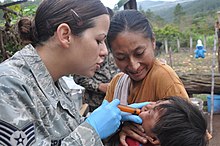Type a search term to find related articles by LIMS subject matter experts gathered from the most trusted and dynamic collaboration tools in the laboratory informatics industry.
| Oral administration | |
|---|---|
 Oral administration of a tablet | |
| Other names | By mouth, per os (PO) |


Oral administration is a route of administration whereby a substance is taken through the mouth, swallowed, and then processed via the digestive system. This is a common route of administration for many medications.
Oral administration can be easier and less painful than other routes of administration, such as injection. However, the onset of action is relatively low, and the effectiveness is reduced if it is not absorbed properly in the digestive system, or if it is broken down by digestive enzymes before it can reach the bloodstream. Some medications may cause gastrointestinal side effects, such as nausea or vomiting, when taken orally. Oral administration can also only be applied to conscious patients, and patients able to swallow.[1]
Per os (/ˌpɜːrˈoʊs/; P.O.) is an adverbial phrase meaning literally from Latin "through the mouth" or "by mouth". The expression is used in medicine to describe a treatment that is taken orally (but not used in the mouth such as, for example, caries prophylaxis).[2] The abbreviation P.O. is often used on medical prescriptions.[citation needed]
Enteral administration includes:[citation needed]
Enteral medications come in various forms, including[3] oral solid dosage (OSD) forms:[4]
and oral liquid dosage forms:[5]
Concomitant ingestion of water facilitates in swallowing tablets and capsules.[6] If the substance has disagreeable taste, addition of a flavor may facilitate ingestion.[6] Substances that are harmful to the teeth are preferably given through a straw.[6]